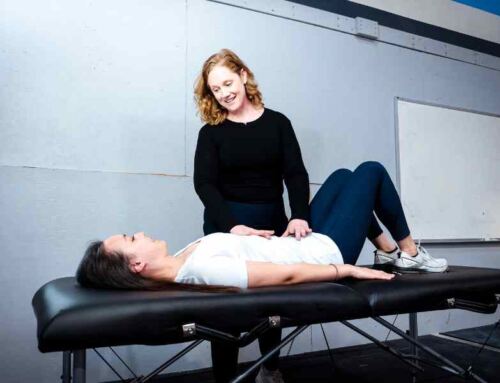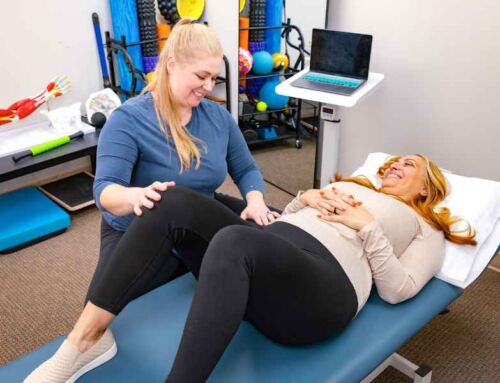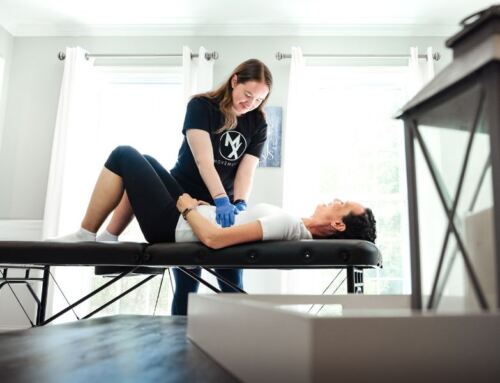When I found out my first child was breech, I was crushed. I had been preparing for a vaginal birth for the past nine months. My training as a pelvic health physical therapist helped me feel connected to my body; I exercised, practiced pelvic floor relaxation, stretched, and meditated regularly. I did everything I recommend to my patients. I felt ready.
When I voiced my disappointment, my OB gently put her hand on my leg and said,
“We don’t deliver breech babies vaginally. There’s too high of a risk of injury to the baby. I’m sorry. Let’s schedule your cesarean. In the meantime, we can try a version to see if the baby will flip.”
When the version didn’t work, I pivoted to preparing for a planned C-section. I had done the physical work, now it was time to prepare mentally. But even as a pelvic health PT, parts of the recovery still surprised me. In this post, I want to dispel common myths about cesarean birth, help you prepare for surgery, and guide you through recovery with tips for healing well and regaining your strength, with the support of MovementX along the way.
Surgery Without Rehab?
Cesarean delivery is the most frequently performed surgery in the world; 38 million annually, with nearly 1.2 million in the U.S. alone, accounting for about 30% of all births. And yet, unlike other major surgeries, most patients go home with little to no rehabilitation support.
Compare this to a total knee replacement: physical therapists visit patients within hours to begin range of motion, pain management, walking, and daily activities. After a C-section? You’re expected to figure it out by yourself…while caring for a newborn.
At MovementX, we believe that needs to change. We equip our patients to anticipate their recovery and guide them from pregnancy through postpartum so they can heal, care for their baby, and feel confident in their recovery.
The Truth About C-Sections: Dispelling Common Myths
Myth #1: A C-section is the “easy way out.”
Cesarean birth is major abdominal surgery. It requires careful healing, especially in the early postpartum period. Your abdominal wall and pelvic floor both experience trauma. You’re not just recovering from surgery, you’re doing it while caring for a newborn. It’s anything but “easy.” Recovery takes time, at least 18 months and up to 2 years or longer for full healing.
Myth #2: You can’t have a vaginal birth after a C-section (VBAC)
VBAC is possible for many people, depending on the type of incision and individual health factors. Work closely with your OB or midwife, and know that pelvic health physical therapy can prepare your body for a successful VBAC (think of it like an athlete training for a marathon).
Myth #3: You’ll be disconnected from your baby after a C-section
You can still bond immediately with your baby. Request clear drapes, immediate skin-to-skin, music during surgery, and a slower delivery to mimic a vaginal birth. Talk to your birth team in advance about your preferences. If you feel you need an advocate in the operating room, consider hiring a doula to enhance your birth experience.
Myth #4: You won’t have pelvic floor issues if you have a C-section
Pregnancy alone stresses the pelvic floor. Plus, trauma from surgery can lead to issues like diastasis recti, pelvic organ prolapse, pain, or incontinence. A pelvic health PT can help reduce the risk of these conditions or treat symptoms early.
Myth #5: You can’t breastfeed after a C-section
Breastfeeding is absolutely possible. It may take some extra support at first, so don’t hesitate to request help from a lactation consultant in the hospital.
Myth #6: C-section means less vaginal bleeding.
You may still bleed for up to six weeks postpartum, even if you didn’t have a vaginal birth. This is completely normal and part of your body’s healing process.
Myth #7: C-sections negatively affect child development.
No conclusive evidence shows that cesarean birth impacts development. If you have concerns, pediatric physical, occupational, or speech therapists can help monitor and support your baby’s progress.

How to Prepare for a C-section
See a Pelvic Health Physical Therapist
A pelvic health physical therapist can help train your body for surgery so you go in stronger and recover faster. During pregnancy, a pelvic health PT helps you safely maintain strength in your abdominals, pelvic floor, back, and glutes (all muscles that make up your core). PT can also address pain that may develop as the body changes. In the hospital or even before surgery, a pelvic floor PT can coach you through movement, transfers, toileting, and pain management. Postpartum, we begin gentle rehab about two weeks out, guiding you through safe exercises, mobility, and baby care. This preparatory work improves your recovery time.
Mindfulness and Affirmations
Use positive affirmations and mindfulness practices to reduce anxiety leading up to surgery. Watching a C-section video may help you feel more prepared.
Advocate for Your Birth Experience
Consider asking for:
- Clear drapes so you can see your baby
- Immediate skin-to-skin
- Your favorite music or playlist during surgery
- Your partner at your side
- Tubal ligation (if you want permanent birth control)
Tips for the Early Recovery Period (Post-op Day 0-4)
Bed Mobility
Use the log roll method to minimize strain on your abdominals: roll to your side, then push up using your arms as your legs drop down like a pendulum. Typically lowering the head of the hospital bed so it is flat makes this easier to perform.
Coughing
Hug a pillow over your incision when coughing to reduce pain and support your abdominals.
Toileting
Use a squatty potty or foot stool to align your body. Don’t strain or bear down. Relax your pelvic floor and breathe with your diaphragm.
Pain Management
Don’t be a hero. Take pain medication as prescribed. Effective pain control helps you care for your baby more comfortably. It’s okay to take a low-dose opioid if needed, just monitor for constipation. Many moms do well with Tylenol or NSAIDs.
Constipation
The experience of the first postpartum poop always surprises new moms. Constipation is common after surgery.
To decrease pain during defecation as well as prevent and treat constipation, take magnesium citrate supplements and consider using Colace. Eat foods high in both soluble and insoluble fiber. Soluble fiber creates a gelatinous bulk to lower cholesterol. Good sources of soluble fiber include oats, barley, apples, citrus fruits, carrots, peas, and beans. Insoluble fiber adds bulk to stool and can be found in whole wheat flour/bread, wheat bran, nuts, beans, cauliflower, green beans and potatoes.
Start Gentle Exercises
As soon as anesthesia wears off, begin diaphragmatic breathing, pelvic tilts, and bent-knee fallouts to reconnect with your core.
Managing Common Symptoms: Musculoskeletal Pain
Neck or shoulder pain from anesthesia is common and doesn’t usually respond to medication. Sleeping on your left side, using a TENS unit, applying heat, gentle movement and/or massage can help decrease these symptoms in the short term. Pain usually resolves within 24 hours.
Managing Common Symptoms: Urinary Incontinence
Urinary symptoms are common after having a catheter. You might feel like your bladder is full, experience urgency, pain, or even some temporary incontinence. If this happens, focus on diaphragmatic breathing and consciously relax your pelvic floor muscles while urinating. Avoid pushing or bearing down when urinating.
Mobilize Early And Listen To Your Body
Begin walking around your room as soon as anesthesia wears off. Early mobilization (i.e. walking) after surgery has been shown to decrease risk of blood clots, improve strength, and increase recovery time. Start by walking around your room. As you feel able, gradually increase your walking frequency and distance around the maternity ward. Listen to your body. Let your baby stare at lights as you push their bassinet and use this time to catch up with your support person or nursing staff.

Lifting, Breastfeeding, and Protecting Your Core
Lifting
Avoid lifting anything heavier than your baby for the first 4–6 weeks. This will significantly reduce the load on your abdominal muscles and promote healing. Ask for help lifting the baby out of the crib during nighttime feeds. While it’s impossible to avoid all lifting (like a car seat when you are by yourself), try to get help whenever possible.
Breastfeeding
Use pillows to support your arms and back. If you experience neck or back pain, a pelvic health PT can help make breastfeeding more comfortable.
Abdominal Binder
An abdominal binder can offer extra support and pain relief during movement. It is okay to use this in the first 4-6 weeks post-surgery with a goal of gradually weaning from the binder as your abdominals become stronger.
Caring for Your Mind and Body
Stay Active and Listen to Your Body
Continue to be as active as you can when you go home, while still allowing your body to heal. Gentle walks are good. Stop when you feel tired. Remember you have had major abdominal surgery, so take it easy for the first 6-8 weeks, but keep moving.
Watch for Signs of Infection
Call your doctor if you notice:
- Redness, swelling, or drainage at the incision
- Foul smell or pus
- Fever over 100.4°F (38°C)
- Significant increases in pain at the incision site that are not improved with pain meds.
Protect Your Abdomen
Avoid excessive twisting, heavy lifting, or strenuous activity for 6–8 weeks.
Scar Care
Keep your incision clean and dry. Follow your discharge instructions carefully. Once your incision heals, a pelvic health physical therapist can help you with scar mobilization to decrease sensitivity of the scar, improve its appearance, and enhance soft tissue healing.
Final Reminders
- Listen to your body and don’t hesitate to ask for help when you need it.
- Rest as much as possible, especially in the early weeks.
- Stay well-hydrated by drinking plenty of fluids.
- Attend all your scheduled postpartum appointments.
Why Pelvic Health Physical Therapy Matters
At MovementX, we believe in a proactive approach to healthcare. It is never too early in your pregnancy to see a pelvic health physical therapist. If you are preparing for a c-section, a pelvic health physical therapist can help train your body for the surgery, optimizing strength, mobility, and recovery. Our pelvic health PTs will discuss what you can expect with a c-section so you feel empowered and educated going into your surgery.
Because of our mobile, concierge model, we can come to your hospital room after delivery to improve your mobility, healing and function—just like a physical therapist would after joint replacement surgery. While some large hospitals have in-house physical therapists in the maternity ward, most don’t.
After a C-section, your pelvic floor and core need support. Pelvic health PT can:
- Reduce risk of long-term issues like prolapse, incontinence, and back pain
- Improve scar tissue mobility and reduce adhesions
- Rebuild strength and coordination in your abdominal and pelvic floor muscles
- Help you safely return to exercise, intimacy, and daily activities
- Support your mental well-being and confidence in your body
How MovementX Can Help
At MovementX, we come to you—your home, office, gym, or even your hospital room after delivery—so you can get expert care when and where you need it. Our services include:
- One-on-one pelvic health physical therapy
- Personalized prenatal and postpartum care plans
- Postpartum support beginning in the hospital or two weeks postpartum
- Ongoing guidance for scar care, core retraining, return to fitness, and parenting ergonomics
We believe recovery shouldn’t be an afterthought. It should be part of the plan.
Final Thoughts
Recovering from a cesarean birth is no small feat. You’re healing from major surgery while learning to care for a brand-new human. You don’t have to do it alone.
My knowledge as a pelvic health physical therapist helped me recover faster from my cesarean delivery. Though I prepared for a vaginal birth, that preparation paid dividends after my C-section and helped me return to an active lifestyle.
If you’re feeling overwhelmed, in pain, or unsure of your next steps—reach out. Our expert pelvic health physical therapists at MovementX are here to support you every step of the way. Whether it’s during pregnancy, the day after surgery, weeks into recovery, or years after you’ve had your baby, MovementX is ready to meet you where you are.
Let’s work together to help you heal, move, and thrive on your terms.
References
- Segraves RL, Segraves JM. Reducing Maternal Morbidity on the Frontline: Acute Care Physical Therapy After Cesarean Section During and Beyond the COVID-19 Pandemic. Phys Ther. 2021 Jul 1;101(7):pzab093. doi: 10.1093/ptj/pzab093. PMID: 33713410; PMCID: PMC7989147.
- Sultan, Pervez et al. Guidelines for postoperative care in cesarean delivery: Enhanced Recovery After Surgery Society recommendations (part 3)—2025 update. American Journal of Obstetrics & Gynecology, Volume 0, Issue 0








